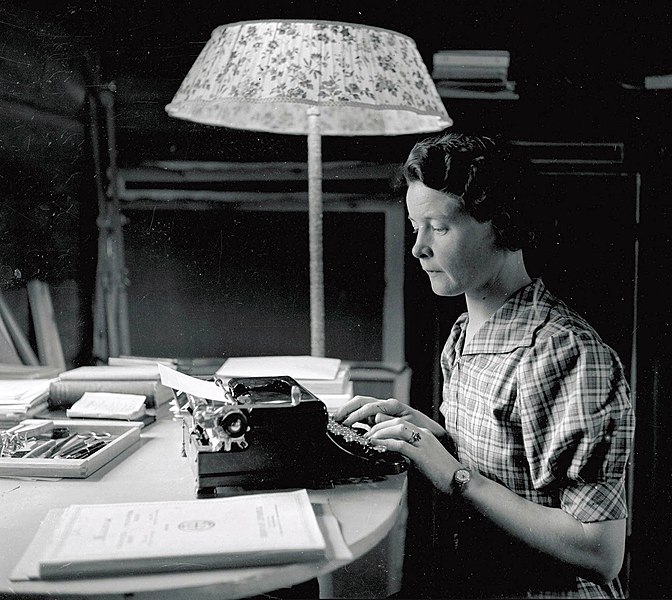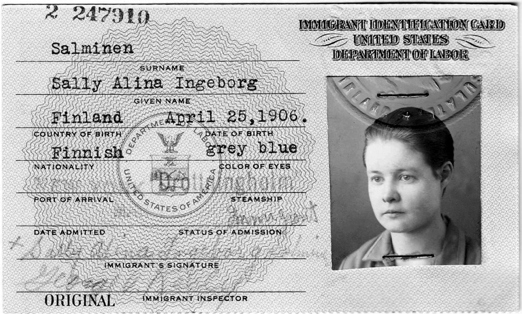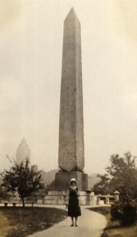The literary work of Sally Salminen
Sally Salminen's famous novel 'Katrina' was published in 1936 and changed her life. From then on, she could afford not to work as a maid and became a writer of both fiction and non-fiction. Her works wrangle with themes such as war and motherhood and deal with issues inspired by her own life which still resonate today.

Motherhood and war
På lös sand (1941) (On Loose Sand), Salminen’s third novel, is a commentary of the Winter War. Here, Salminen examines extremism in various forms of expression: religious revival, communism, patriotism and individualism. She embarks on the psychology of war: Why is making sacrifices so much easier in wartime? But, the novel also raises the question of what is reasonable to sacrifice, and for what purpose.
During the Second World War, Salminen wrote several short prose stories, three of which have the common theme of motherhood and war. One is called ‘Et Barn er født os’ (A Child is Born to Us) which was published by Gyldendal in the magazine Juleroser in 1941. In ‘Kommer Far hjem til Jul?’ (Is Daddy coming home for Christmas?), also published in Juleroser but in 1944, a little girl considers her mother to be a “Furie… with her flying hair and constant agitation.” She does not want war and she does not want to give birth to any more boys, but she wants to write and reveal the truth.
‘Trollet’ (The Troll), which was read on Swedish radio in 1944, is about a Swedish couple in a Stockholm suburb who take care of a war child from Finland. Many children were evacuated from Finland to the other Nordic countries during the Second World War. It can be read as a literary depiction of Salminen’s own experience of taking on a foster child and knowing that the message of peace can, at the same time, mean the loss of a foster child who has become like your own flesh and blood. When the Jewish boy Bent came to the Salminen-Dührkop household in October 1943, it was the beginning of lifelong parenting for them.
Autobiographical elements in her work
With the novel Barndomens land (1948) (The Land of Childhood), Salminen used suggestive, lyrical prose to bring to life the spirited world she moved in as a child. Several critics slated the book – the child’s perspective was considered too poor, the prose too ambitious or rough – but it was also hailed as a pioneering work for the consistent perspective and the frequently forgotten worlds presented in it.
The Land of the Childhood came in the midst of Salminen’s work with the four books on Lars Laurila – Lars Laurila (1943), Nya land (1945) (New Land), Små världar (1949) (Small Worlds) and Klyftan och stjärnan (1951) (The Gorge and the Star). It is as if, with these autobiographical novels, she explores what it could have been like if she were born a boy, but, here too, she also depicts her own life in many ways up to the period of time just after her breakthrough as a novelist. She wrote about her own life to highlight class differences and the experiences of the “underclass”. By this, she meant country people, subordinate even to the working classes of the city.
Salminen wrote three more novels – Prins Efflam (1953) (Prince Efflam), Spår på jorden (1961) (Traces on Earth) and Vid havet (1963) (By the Sea) (1963). Prince Efflam, together with Katrina and By the Sea, represent Salminen’s greatest success. In the contemporary novel Prince Efflam, Salminen examines how good and evil can exist simultaneously. A drama takes place around the war criminal Efflam Kelou. He floats ashore on a beach in northern Brittany in the late 1940s and appears as a fairy tale prince and saviour figure – as long as he suffers from memory loss. With Prince Efflam, Salminen again aroused the interest of critics on a wider front. The book has been described as both a great epic, a modernist experimental as well as a piece of the literary genre Grotesque.

PICTURE: Sally Salminen with her modern short haircut on an immigrant ID card given by the U.S. Embassy in Helsingfors, November 18, 1929. Source: Mariehamns stadsbibliotek.
The ordinary man
Traces on Earth takes place in the Åland countryside and is an ode to the ordinary man, the farmhand and the maid, who all leave concrete traces on the earth. The novel is also a tragedy about the unsuccessful individualist Sven, who has gone out into the world to seek happiness but feels as if he is being buried alive. It is as if the author, with the portrait of Sven, wishes to investigate some of the worst aspects of her own life choices. For example, due to her growing experience, there is a gaping ‘gorge’ (as in the title of the The Gorge and the Star) that opens up between those who remained in the village where she grew up and her, the one who left. However, she continued to maintain that freedom was her highest ideal, and was of the view that as long as you can manage to travel, you should do so; this physical mobility seems to correspond with a mobility of mind, that is, never to settle for simplified answers. In Traces on Earth, Sven disappears – without a trace – after an unsuccessful attempt at getting revenge on his birth place. He has a spiritual relative in Jens Söffrensen, the main character in the philosophical novel By the Sea, who has returned to the Danish island of Fanø, where he was born and raised, and is forced to make up his mind about himself and life. Salminen received much appreciation for the portrayal of Fanø’s maritime history and distinctive environment in Denmark.
Sally Salminen's travels and memoirs

Sally Salminen gives an account of her life in Upptäcktsresan (1966) (The Trip of Discovery), Min amerikanska saga (1968) (My American Fairy Tale), I Danmark (1972) (In Denmark) and Världen öppnar sig (1974) (The World Opens). The first memoir extends to her move to America, the second depicts her life as a maid in a number of workplaces and Scandinavian immigrant life in 1930s New York and its surroundings, as well as the beginning of her literary success. The last two books essentially cover the years 1940–1947, a period marked by World War II and Nazi Germany’s occupation of Denmark. During this time, Salminen suffered from mental illness, but she was also very productive and produced three novels, some short prose and debate articles.
PICTURE: Sally Salminen standing in front of the Washington Memorial in New York. Source: Sällskapet Salminens Vänner rf.
Shortly after the advent of peace in 1945, when she experienced the world opening up again, Salminen wrote several travel articles that were published in, for example, the Danish newspaper Politiken. The travel stories Jerusalem (1969) and På färder i Israel (1971) (Travelling in Israel) were the result of a trip to the historic area of Palestine in 1967–1968. There are travel journals among her literary papers, one of which is from a two-month road trip through Germany, Italy and Yugoslavia in 1963. The archive also contains diaries, recorded dreams and other notes, calendars, letters, photographs and unpublished manuscripts, not least plays.
You can read Sally Salminen's biography on nordics.info by clicking here.
Literary works mentioned in this article:
- På lös sand (1941) (On Loose Sand)
- 'Et Barn er født os’ (1941) (A Child is Born to Us)
- Lars Laurila (1943)
- ‘Kommer Far hjem til Jul?’ (1944) (Is Daddy coming home for Christmas?)
- ‘Trollet’ (1944) (The Troll)
- Nya land (1945) (New Land)
- Barndomens land (1948) (The Land of Childhood)
- Små världar (1949) (Small Worlds)
- Klyftan och stjärnan (1951) (The Gorge and the Star)
- Prins Efflam (1953) (Prince Efflam)
- Spår på jorden (1961) (Traces on Earth)
- Vid havet (1963) (By the Sea)
- Upptäcktsresan (1966) (The Trip of Discovery)
- Min amerikanska saga (1968) (My American Fairy Tale)
- På färder i Israel (1971) (Travelling in Israel)
- I Danmark (1972) (In Denmark)
- Världen öppnar sig (1974) (The World Opens)
Further reading:
- Michel Ekman ed., Finlands svenska litteratur 1900–2012 (Finland’'s Swedish literature 1900–2012),(Helsingfors: Svenska litteratursällskapet i Finland & Stockholm: Bokförlaget Atlantis, 2014).
- Roger Holmström, ’Against all odds. Sally Salminen’s Katrina and the possibilities of cultural transfer’, Battles and Borders. Perspectives on Cultural Transmission and Literature in Minor Language Areas, ed. Petra Broomans et al, (Groningen: Barkhuis 2015), pp. 97–107.
- Tuva Korsström, ’A maid’s bestselling novel’, nordicwomensliterature.net, 17 February 2012.
- Ulrika Gustafsson, Min ljusa stad. Sally Salminen, livet och litteraturen (My bright city. Sally Salminen, life and literature), (Stockholm: Appell Förlag & Helsingfors: Svenska litteratursällskapet i Finland, 2019).
- Ulrika Gustafsson, ’Stjärna, medelmåtta eller före sin tid? Om Sally Salminens återkomst’ (Star, second-rater or ahead of her time? About Sally Salminen’s return], ledare för Lysmasken, webbplats för litteraturkritik (Leader of Lysmasken, website for literary criticism), 23 December 2019.
Links:
- ’Sally Salminen’ on nordicwomensliterature.net (in English, Danish and Swedish).
- Podcast ’Peppe möter’, [Pepe Meets] with Peppe Öhman and Ulrika Gustafsson discussing Sally Salminen and her authorship (in Swedish).
This article was submitted in Swedish and was translated in-house by nordics.info with assistance by the author.